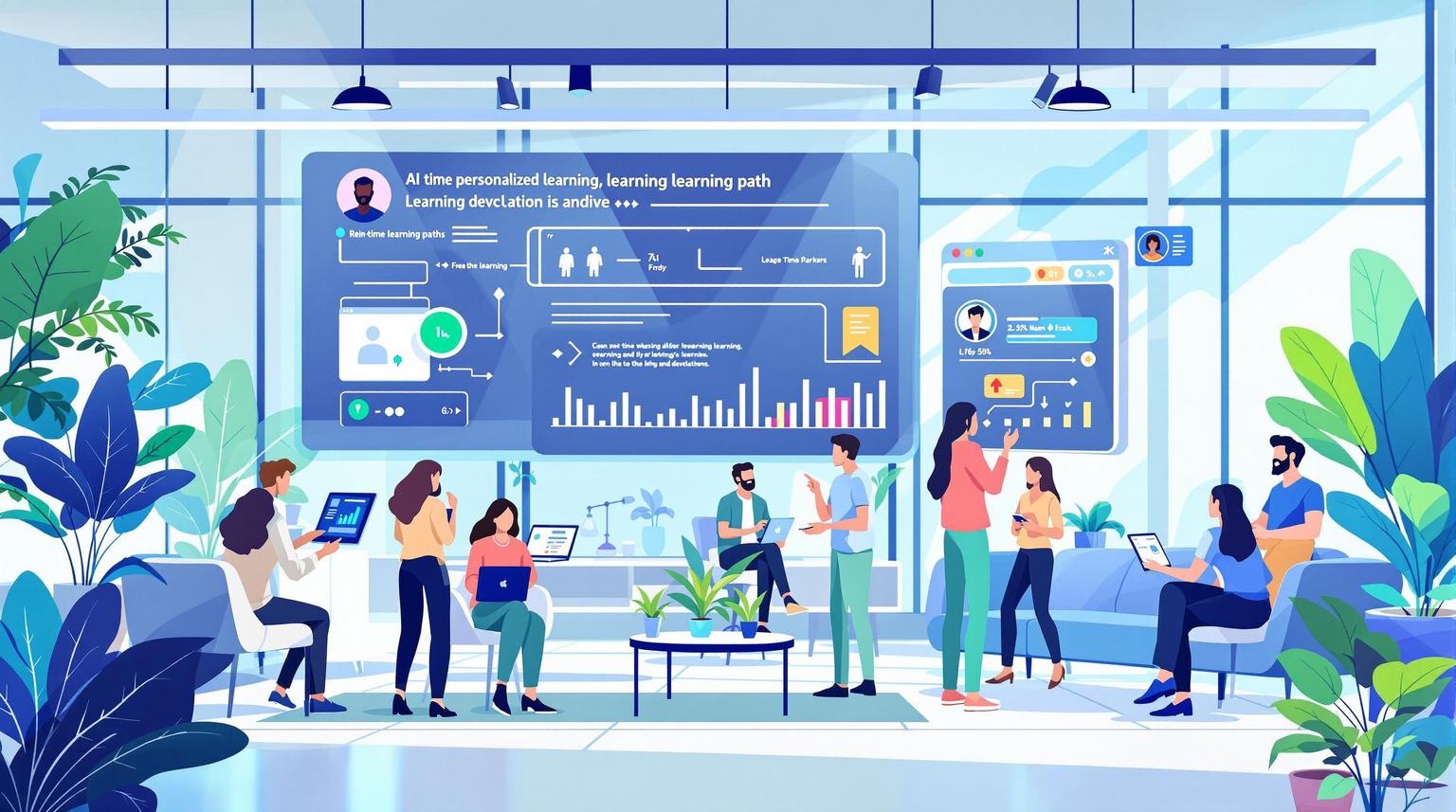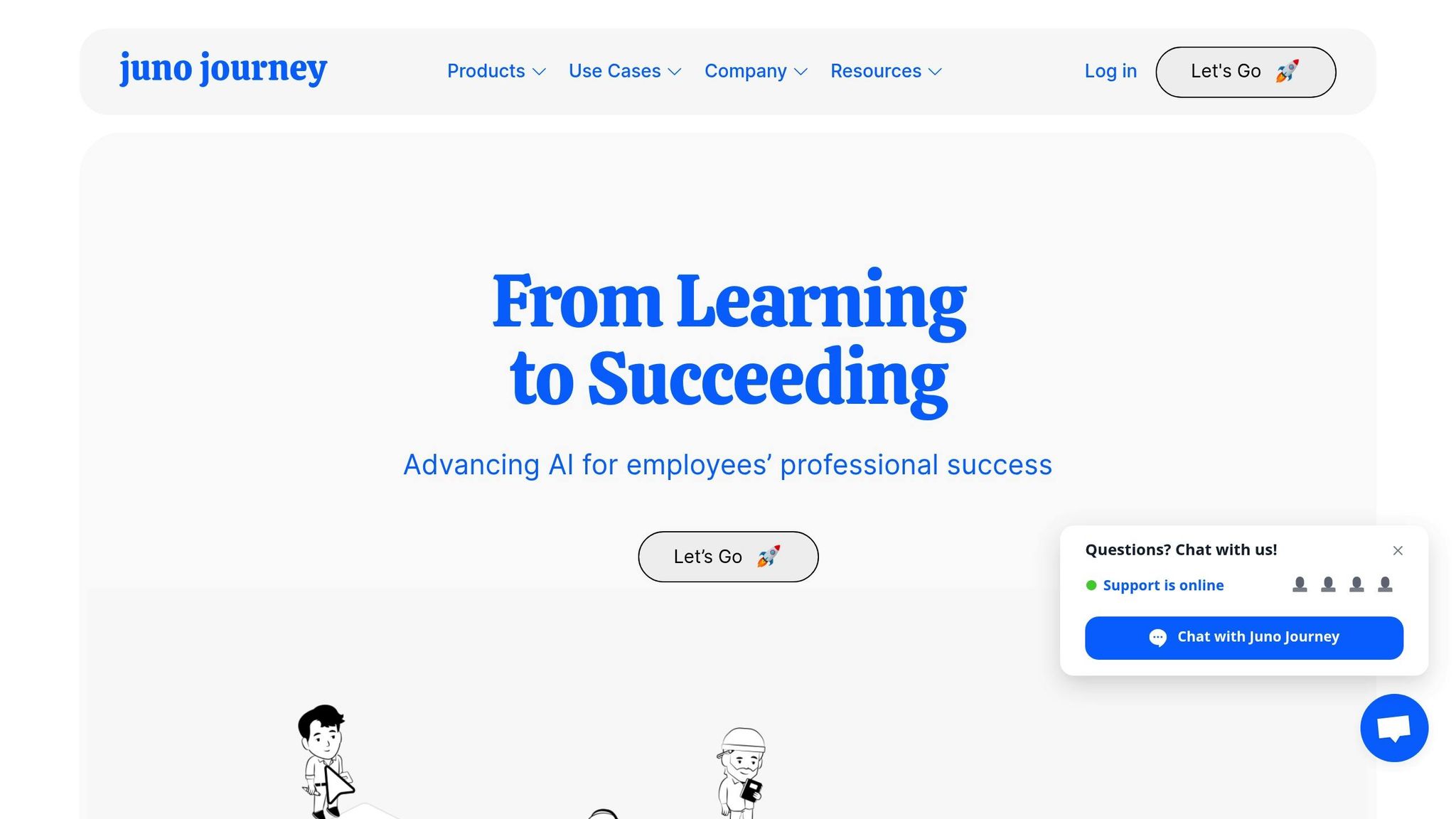
AI-Driven Learning Paths: How It Works
AI-driven learning paths use advanced algorithms to personalize employee training. Here’s what you need to know:
-
Key Benefits:
- 90% employee success rate
- 96% engagement in learning programs
- 20% faster onboarding times
- 46% increase in overall engagement
-
How It Works:
- Uses data like skills, role requirements, and learning history.
- Tracks progress, identifies skill gaps, and adjusts training in real time.
- Delivers tailored content and personalized guidance.
-
Real Results:
- Companies like Kaltura, Trax Retail, and Rapyd report improved onboarding, engagement, and knowledge sharing.
AI-powered tools like Juno Journey make training more efficient, aligning learning with company goals while keeping employees engaged.
Data Collection and Analysis
Sources of Learning Data
AI-driven learning systems gather a variety of data to create personalized learning experiences. Key sources include:
- Skills Assessment: Identifies existing abilities and highlights areas for improvement.
- Learning History: Tracks completed courses to avoid repeating content.
- Performance Data: Monitors progress and adjusts difficulty levels accordingly.
- Role Requirements: Aligns learning with job-specific needs.
- Learning Preferences: Determines preferred formats to enhance engagement.
This data is essential for the AI to analyze and deliver tailored learning paths.
How AI Analyzes Learning Data
Once collected, the AI uses advanced techniques like pattern recognition, behavior analysis, skill gap identification, and progress tracking to craft and refine personalized development plans. For example, Juno's AI Assistant has shown impressive results, achieving a 90% success rate for employees and boosting engagement by 46%.
Keeping Data Secure
The system prioritizes user privacy and security during data processing by implementing strict measures:
- Encryption: Protects data during transmission and storage.
- Access Controls: Restricts access based on user roles.
- Data Anonymization: Ensures privacy by analyzing data without revealing personal details.
- Compliance Monitoring: Conducts regular audits to stay aligned with security standards.
These protocols ensure that user data remains secure and private while supporting effective personalized learning.
Creating Personal Learning Paths
Smart Content Selection
AI is changing the way learning content is tailored to meet individual employee needs. By analyzing data like skills, role requirements, and career goals, these systems pinpoint the most relevant content for each person.
For example, Juno Journey's AI-powered LMS boasts a 90% employee success rate. It stands out by:
- Pinpointing skill gaps using analytics
- Aligning learning materials with company goals
- Instantly recommending tailored resources
"Juno's AI-powered LMS lets you create engaging, goal-driven training in minutes so employees get what they need, when they need it."
Learning Style Matching
AI doesn’t just select content - it also personalizes how it's delivered. By considering factors like engagement, completion rates, and time spent on modules, the system adjusts the format and pace to suit each learner.
"AI-driven PDPs deliver personalized recommendations paired with curated content, ensuring comprehensive employee development."
This approach has led to a 96% engagement rate and a 46% boost in overall employee participation. The Knowledge Assistant further enhances the experience by offering context-aware guidance, helping employees stay on track with their learning while aligning with company objectives.
sbb-itb-612c355
Progress Tracking and Updates
Performance Monitoring
AI-powered platforms use real-time analytics to track employee development. These systems monitor learning activities and provide instant insights into progress and skills.
Modern AI tools focus on three main areas:
- Skills Gap Analysis: Automatically pinpoints knowledge gaps by comparing current abilities to role requirements.
- Progress Metrics: Tracks completion rates, engagement levels, and time spent on learning in real time.
- Goal Alignment: Evaluates how individual learning efforts align with company goals.
"Get real-time, actionable analytics that track progress, identify skill gaps, and ensure learning drives measurable growth."
The real-world impact of AI tracking is clear. For example, Trax Retail significantly boosted learning engagement by integrating AI monitoring, increasing monthly active users from 4% to over 50%.
To enhance these tracking capabilities, immediate feedback systems help fine-tune learning approaches.
Quick Response System
Quick response features bring noticeable improvements by evaluating learner performance and adapting content delivery to individual needs.
"Juno's AI Assistant delivers context-aware answers, providing real-time guidance tailored to roles and tasks."
These systems work alongside analytics to adjust learning paths dynamically. Key benefits include:
- Context-Aware Guidance: Offers personalized support based on specific roles and tasks.
- Automated Engagement: Keeps learners motivated and engaged.
- Adaptive Pathways: Modifies learning paths based on performance and participation levels.
Measuring Success
Learning Analytics
AI-powered analytics tools help measure learning outcomes by tracking both individual progress and organizational achievements. These tools build on earlier performance monitoring to confirm the broader effects of AI-driven learning programs.
Here are three key areas to focus on:
| Metric Category | What to Track | How It Helps |
|---|---|---|
| Engagement | Monthly active users, participation rates | Indicates program adoption and reach |
| Progress | Completion rates, speed of skill acquisition | Evaluates learning effectiveness |
| Business Impact | Time savings, productivity gains | Demonstrates return on investment (ROI) |
Examples like Trax Retail and Kaltura illustrate how these metrics translate into measurable benefits.
Business Results
These metrics don’t just track learning progress - they reveal how learning initiatives drive business success. AI-driven learning paths have been linked to better operational efficiency and improved learning experiences.
Some key results include:
- 20% shorter onboarding times
- 90% employee success rate
- 96% engagement across learning programs
At Rapyd, the use of Juno Journey created a shared knowledge base that improved cross-departmental understanding of payment industry concepts:
"Using Juno, we were able to bring together all of our internal experts to create a common baseline capturing the core of the payment industry to better all of our employees, regardless of their role. We used Juno's features to enhance employees learning experiences." – Ziv Rumack Kazes, Learning & Development @Rapyd
Flipp also leveraged Juno Journey to transform its content creation process, fostering better collaboration between employees and managers.
Organizations demonstrate ROI by narrowing skill gaps, fostering employee growth, streamlining workflows, and improving team collaboration.
Juno Journey Platform Overview

Platform Capabilities
Juno Journey's platform is built around three main hubs: Training, Growth, and Talent. Its AI engine analyzes learning data to create tailored development paths that align with both personal goals and organizational needs.
Here’s a breakdown of its core features:
| Feature | Function | Benefit |
|---|---|---|
| AI Knowledge Assistant | Delivers real-time, context-specific guidance | Supports role-specific learning needs |
| AI Authoring Tool | Automates the structuring of courses | Ensures content aligns with goals |
| Smart Automation | Monitors learning progress automatically | Minimizes manual oversight |
| Analytics Dashboard | Tracks progress in real time | Helps make informed, data-based decisions |
For example, at Trax Retail, these features drove a major engagement boost, increasing monthly active users from 4% to over 50%. This technology creates a strong base for linking learning directly to growth.
Learning Culture Development
Juno Journey promotes continuous learning that delivers measurable outcomes. Using AI-powered Personal Development Plans (PDPs), employees get tailored recommendations from a library of content sourced from over 150 providers.
Kaltura's experience highlights how the platform improves onboarding and streamlines team workflows.
Key results include:
- 96% engagement rate across learning programs
- 90% success rate in achieving learning objectives
- 46% rise in overall employee engagement
Conclusion
Main Points Review
AI-powered learning paths have reshaped how employees develop skills by using smart automation and tailored experiences. Many organizations have seen impressive results, including:
| Metric | Result |
|---|---|
| Employee Success Rate | 90% |
| Learning Engagement | 96% |
| Overall Engagement Growth | 46% |
| Onboarding Efficiency | 20% faster |
These results highlight the growing impact of AI in improving workplace learning.
Future Developments
The future of AI-driven learning paths looks promising, with advancements aiming to make learning even more customized and efficient. Some upcoming improvements include:
- Smarter AI tools for quicker content creation
- Better personalized development plans
- Advanced real-time knowledge support
- Stronger integration with workplace tools
As these technologies evolve, companies can create more connected and collaborative learning environments, making knowledge sharing a natural part of their culture.